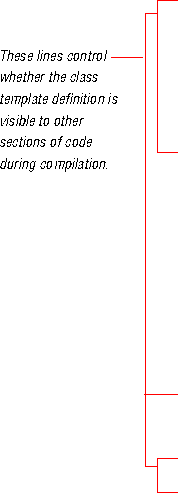HIDE_TEMPLATE_DEFINITIONS when you build your project, you must make modifications to the source files that define your class templates.
NOTE
Source file
modifications
This source file defines a class template TNotificationMemberFunctionOf<AReceiver>:
NOTE // Copyright (C) 1995 Taligent, Inc. All rights reserved.
#ifndef Taligent_MEMBERFUNCTIONCONNECTION
#define Taligent_MEMBERFUNCTIONCONNECTION
#ifndef Taligent_PRIMITIVETYPES
#include "PrimitiveTypes.h"
#endif
 #ifndef HIDE_TEMPLATE_DEFINITIONS
#define MAKE_TNotificationMemberFunctionOf_DEFINITIONS_VISIBLE
// ... more #defines for other template definitions in this file
#else
#define inline
#endif
#ifdef MAKE_TNotificationMemberFunctionOf_DEFINITIONS_VISIBLE
TemplateDefinitionsMacro(TNotificationMemberFunctionOf,AReceiver);
template <class AReceiver>
inline
TNotificationMemberFunctionOf<AReceiver>::TNotificationMemberFunctionOf(
MemberFunction theFunction) :
fFunction( theFunction )
{
}
// ... more definitions for this class
#endif
// ... more code
#ifdef HIDE_TEMPLATE_DEFINITIONS
#undef inline
#endif
#ifndef HIDE_TEMPLATE_DEFINITIONS
#define MAKE_TNotificationMemberFunctionOf_DEFINITIONS_VISIBLE
// ... more #defines for other template definitions in this file
#else
#define inline
#endif
#ifdef MAKE_TNotificationMemberFunctionOf_DEFINITIONS_VISIBLE
TemplateDefinitionsMacro(TNotificationMemberFunctionOf,AReceiver);
template <class AReceiver>
inline
TNotificationMemberFunctionOf<AReceiver>::TNotificationMemberFunctionOf(
MemberFunction theFunction) :
fFunction( theFunction )
{
}
// ... more definitions for this class
#endif
// ... more code
#ifdef HIDE_TEMPLATE_DEFINITIONS
#undef inline
#endif
HIDE_TEMPLATE_DEFINITIONS disables the use of inline in class template definitions in order, to work around a compiler idiosyncracy that prevents other libraries from accessing functions defined as inline. Managing class
template
dependencies
If you develop several shared libraries, and one library defines a class template that the other libraries use to instantiate template classes, you should instantiate your template classes according to these guidelines:
For example, suppose you have developed shared libraries LibA, LibB, and LibC, and that LibA defines the class template ATemplate<Type>. If both LibB and LibC use instantiations of ATemplate<Type>, you should place these instantiations in the instantiations file for LibA (see "Generating template class instantiations" on page 70). If only LibB uses instantiations of ATemplate<Type>, however, you should place the instantiations in the instantiations file for LibB. As the dependencies between your libraries evolve, you might want to move certain template class instantiations from one library to another.
As the dependencies between your libraries evolve, you might want to move certain template class instantiations from one library to another.
[Contents]
[Previous]
[Next]
![]() Click the icon to mail questions or corrections about this material to Taligent personnel.
Click the icon to mail questions or corrections about this material to Taligent personnel.